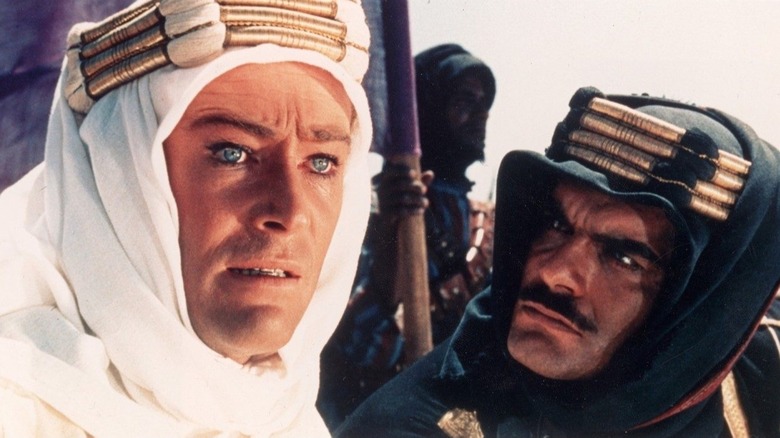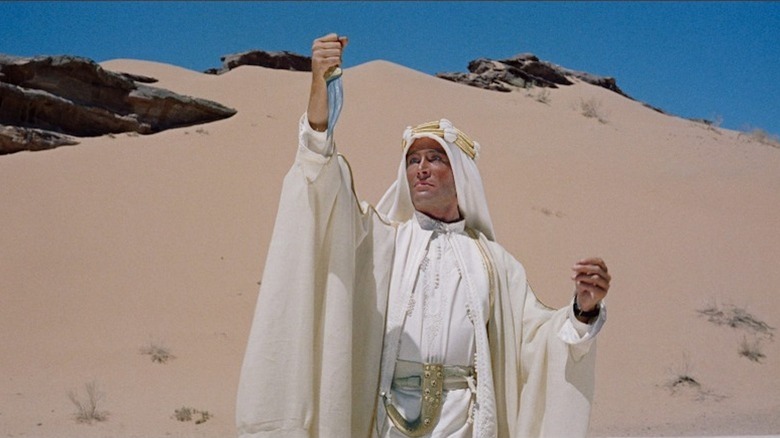When the British Movie Institute’s official publication, Sight and Sound, launched its decennial “Best Movies of All Time” checklist in 2022, there was a notable — some would possibly say stunning — omission from the highest 100: David Lean’s unimpeachably masterful epic, “Lawrence of Arabia,” was nowhere to be discovered. Although the movie had been sliding down the checklist all through the early twenty first century (it ranked 51 in 2002 and tumbled to 81 in 2012), many people felt there was a flooring for a movie as universally revered as Lean’s biographical drama concerning the turbulent (doubtless exaggerated) desert adventures of T.E. Lawrence. Despite the fact that the movie does have a white savior factor to it, Lean, screenwriter Robert Bolt, and star Peter O’Toole painting Lawrence as a harmful thrill-seeker with a messiah complicated. His fervor is each rousing and terrifying.
Whereas I feel the subject material in “Lawrence of Arabia” is likely to be an computerized turnoff for some critics, I additionally really feel the movie’s decline in crucial esteem is because of its very specific aesthetic. Lean’s film is hardly alone in being a see-it-big 70mm expertise, however not like “Ben-Hur” (1959), “Cleopatra” (1963), and “The Sound of Music,” it does not have a conventionally paced narrative or a great deal of unforgettable songs to maintain viewers engaged after they watch it at dwelling. Bear in mind, these films put up massive Nielsen rankings numbers when individuals have been watching them cropped for 4×3 tubes (typically in black-and-white). “Lawrence of Arabia” did not captivate in the identical approach. It was shot on Panavision Tremendous 70mm to be projected on 70mm movie within the largest theater obtainable.
That is tragically near not possible these days, once you’re fortunate if there is a home with an working 35mm projector inside 100 miles of your private home. 70mm? At the moment, there are barely over 60 theaters merely able to projecting a movie on this format. Issue within the variety of screenable prints of “Lawrence of Arabia” and Sony’s willingness to lend one out to a theater outdoors of Los Angeles, and the overwhelming majority of cinephiles must construct a West Coast trip round a 70mm displaying of Lean’s film.
Heck, it is possible that the overwhelming majority of movie critics and administrators polled by the BFI have by no means seen “Lawrence of Arabia” in 70mm. And it is a disgrace as a result of it is solely Steven Spielberg’s favourite film of all time.
No Lawrence of Arabia, no Spielberg
When Columbia Photos launched movie preservationist Robert A. Harris’ restoration of Lean’s lower of “Lawrence of Arabia” in 1988, Steven Spielberg joined Martin Scorsese and the studio’s then president Daybreak Metal at a Manhattan press convention to gush over the movie’s impact on his life and profession. “‘Lawrence of Arabia’ was the primary movie I noticed that made me wish to be a moviemaker,” stated Spielberg. “It was in Phoenix, I used to be 13 or 14 on the time, and it was overwhelming.”
In a video interview that’s not presently on-line (however has been quoted extensively by Far Out), Spielberg elaborated on this expertise. “I could not comprehend the enormity of the expertise,” he stated. “So I wasn’t capable of digest it in a single sitting. I really walked out of the theater surprised and speechless.” There have been no DVD commentaries or behind-the-scenes featurettes to look at on YouTube. All he had for some time was a vinyl LP of Maurice Jarre’s soundtrack, which included a booklet that mentioned in terse element the manufacturing of the film. “I needed to know the way that movie was made,” he stated.
I’ve heard and browse Spielberg speak about “Lawrence of Arabia” so many instances, I used to be surprised that he did not work the aforementioned expertise into his semi-autobiographical movie “The Fabelmans.” To be honest, that movie is so masterfully constructed itself that I do not know the place or how you’ll match a “Lawrence of Arabia” scene into it, however each time I’ve watched the film, Spielberg’s feedback — and people of Scorsese and Ridley Scott, each of whom contemplate the movie considered one of their favorites — have knowledgeable my understanding of and stoked my very own love for Lean’s masterpiece.
And that is one factor I am lucky sufficient to say I’ve in frequent with Spielberg: I’ve seen “Lawrence of Arabia” projected in 70mm.
If you happen to’ve by no means seen Lawrence of Arabia on 70mm, you’ve got by no means seen Lawrence of Arabia
My first go-round with “Lawrence of Arabia” was throughout that 1988 re-release. The movie performed at Toledo, Ohio’s Showcase Cinemas, which, earlier than it was demolished within the 2000s, had two seemingly cavernous 70mm homes. I used to be 15 on the time, and was simply getting over my resistance to basic films. I will not lie: having my mother and father drive me and my pal Dave as much as that theater to look at a four-hour film that gained the Oscar for Greatest Image a decade earlier than I used to be born felt a bit like homework. However when Lean lower from O’Toole blowing out that match to the solar rising within the Arabian desert, the movie solid its spell, which even the intermission could not break.
Once I moved to Los Angeles in 2002, I made it some extent to see “Lawrence of Arabia” on 70mm (often on the American Cinematheque’s Aero Theatre) as typically as potential. I went with my pal Drew McWeeny on a few events, and admired his coverage of all the time bringing a unique pal who’d by no means seen the movie in 70mm (or in any respect) to every screening. On one journey, I could not assist however discover Alfonso Cuarón seated close to the entrance row of the Aero. I want to hell I might’ve picked his sensible mind after that screening. (Ridley Scott introduced it up once we did a Q&A for his lower of “Kingdom of Heaven,” and once more once I interviewed him for “American Gangster.”)
However realizing it is Spielberg’s favourite, he is the artist I lengthy to talk with at size. I wish to know the place “Lawrence of Arabia” exists within the DNA of all of his movies, and what he thinks younger filmmakers ought to take from it. Largely, I need him to strengthen the significance of seeing it in 70mm. As a result of I simply do not perceive how a movie of its impeccable craftsmanship and life-altering magnitude is not in additional critics’ high 10 lists. This is not a matter of obligation. It is concerning the film’s standalone greatness. As Roger Ebert as soon as wrote, seeing “Lawrence of Arabia” projected on 70mm movie “is on the brief checklist of issues that should be accomplished through the lifetime of each lover of movie.”
There may be nothing prefer it, and, as Spielberg famous in that video interview, there’ll by no means be something prefer it once more. Per the person who gave us “Jaws,” “E.T. the Further-Terrestrial,” “Schindler’s Record” and so many different classics:
“What makes that movie unlikely any movie that may be made once more is that it was accomplished naturally; with the weather of sunshine and sound and perhaps the best screenplay ever written for the movement image medium […] It was a miracle.”

